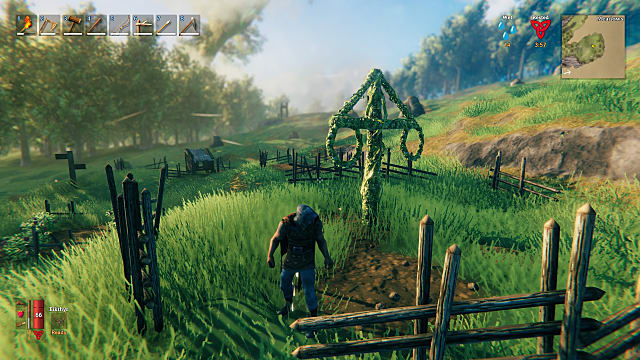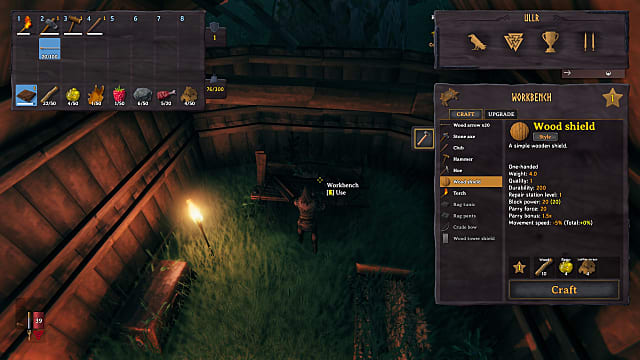I’ll go over the basics of building, why structural integrity matters, how to build defenses, and why the hoe tool can be your best friend. Hopefully, these tips and tricks will help you get a better understanding of building and make your exploration of Valheim more enjoyable.
Valheim Building: The Basics
To get started, you’re going to need a hammer, a hoe, and materials to build a workbench.
The hammer is your go-to item for crafting, giving you access to all of the recipes you’ve unlocked thus far from the resources you’ve gathered. The hoe allows you to flatten and raise terrain, as well as create paths. The workbench marks your building area with a white circle. You can have multiple workbenches spread out to increase the total building area, and if you build one near an abandoned shelter, you can easily dismantle that shelter for wood.
Ideally, you want to build your house close to some woods, as you’ll need a fair bit of lumber to construct even a small, basic house. In the early game, you can get away with a 3x3 floor design; campfire in the middle, bed on one wall, and workbench on the other.
Eventually, you’ll want to build a smelter, charcoal kiln, and forge, the latter of which will allow you to craft even more weapon and armor recipes.
Structural Integrity
Valheim buildings have structural integrity. It goes off a color system you can see in the building screen when you hover over something like a wall, floor, or ceiling piece. The colors range from blue/green/yellow/red, with red being the danger zone.
Floors touching the ground — and the first level of walls — will be blue, showing that they are foundational pieces and have the highest level of strength.
Some ceiling pieces attached to a single wall will be yellow, indicating they are compromised, and further connections could make them weaker. And if you attach a wood beam to the ceiling without any support, it will be red — and likely break apart immediately.
Luckily, there are plenty of support pieces, like posts and support beams, in the game that help boost structural integrity, making them not only decorative but functional.
Your wooden structures will also suffer decay if you’re not using a proper roof to cover the structure.
Be Careful of Smoke Accumulation/Inhalation
Having a campfire or hearth inside your home actually causes smoke to accumulate inside the building, which can cause you to suffer damage from smoke inhalation.
The easiest way to deal with accumulating smoke is to simply remove the section of the roof directly over the fire. But that puts the fire at risk of being doused out during a rainstorm, keeping you from being able to sleep in your bed, cook food, or use it as a respawn point.
To get around this problem, you could build a layer of half walls on top of a layer of full walls, leaving an opening for smoke to funnel out of the house. You could also build a makeshift chimney on top of the house to keep the rain out or have some “windows” in place to give the smoke a way to dissipate.
There are multiple routes, but you must take one.
Build Defenses
Wild beasts roam Valheim, and some will come near your base at night. Many won’t attack outright, but you may be vulnerable if you leave your house. Likewise, t>here is a chance for a random event to trigger, causing your base area to come under siege at night.
Regardless of the situation, it’s a good idea to build some defenses around your base, especially if you’re on the edge of your biome like I am: straddling the line between the Meadows and the Black Forest.
Building an outer perimeter of Stakewalls gives you a measure of protection. You could even build some platforms along the wall to shoot invaders. Aside from Stakewalls, consider placing some standing torches around your house and base to aid in seeing where enemies might be concentrating their attacks. Raid nights are especially dark and foggy.
If your walls and defenses take damage, you can repair them with your hammer while trying to wait out the attack. That’s instead of going on the offensive, which, depending on the composition of the attacking party, might be the route to go.
Since enemies can damage your buildings, it’s also a good idea to have your crafting stations behind cover as well; you don’t want them to destroy your smelter mid-operation and cause your hard-found ore to disappear.
Remember that location is key because buildings require planning to be structurally sound, and defensive measures should be taken to protect your resources from the varied foes Valheim has to offer. For more tips and tricks, consider checking out our other guides, like our starter guide, how to repair your tools and buildings, the different ways you can remove items from your inventory, or how to get the fishing rod.



